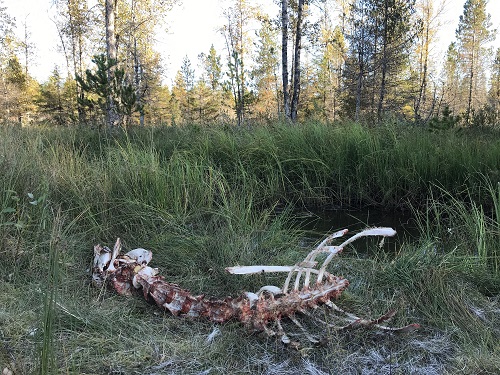By Gretchen Roffler, Alaska Department of Fish and Game and Susannah Woodruff, Alaska Department of Fish and Game
Are wolf predation rates and prey preference different during summer and winter?

Alaska Department of Fish and Game
Dates
2018–2023
mid-August through mid-September
mid-February through mid-March
mid-August through mid-September
mid-February through mid-March
Did You Know?
- Wolves are generalist predators
- Wolves eat fish and marine mammals in coastal environments
- Diets of Glacier Bay wolves have shifted from marine mammals to moose to sea otters over the past 3 decades
Introduction
Wolves are habitat generalists occupying a wide array of ecoregions and can exploit a variety of locally available prey species opportunistically. Ungulates (i.e., moose, deer) are the main prey of wolves throughout their range; however, wolf diets are diverse and include alternate prey such as beaver, small mammals, birds, bears, and berries. Coastal wolves (i.e. Alexander Archipelago wolves) are considered distinct from continental populations due to morphological, genetic, and ecological characteristics. The seasonal use of marine resources such as salmon and seals is well-documented in coastal wolves. Less understood is the influence that marine resources have on wolf predation rates of other species such as moose, deer, and bears. For example, do abundant marine resources increase the wolf population size leading to increased predation of moose? Or alternatively, do wolves prefer to eat spawning salmon because they are predictable and non-risky to catch as opposed to moose, which can be dangerous and time-consuming to hunt? Does this preference lead to decreased moose predation rates during the spawning season?
The goal of this project is to characterize variation in seasonal patterns of wolf predation due to differences in prey vulnerability, and availability of alternate prey. Specifically, we will estimate wolf kill rates during late summer and late winter in a temperate coastal ecosystem. This research will further provide information regarding wolf prey selection in multiple-ungulate systems, the age and sex structure of the prey, and influences of the nutritional condition on kill rates.
The goal of this project is to characterize variation in seasonal patterns of wolf predation due to differences in prey vulnerability, and availability of alternate prey. Specifically, we will estimate wolf kill rates during late summer and late winter in a temperate coastal ecosystem. This research will further provide information regarding wolf prey selection in multiple-ungulate systems, the age and sex structure of the prey, and influences of the nutritional condition on kill rates.
Methods

Alaska Department of Fish and Game
We will estimate minimum counts of wolf packs in the study areas by quantifying wolves observed accompanying radiocollared wolves during aerial telemetry flights. We will also deploy and monitor motion-detecting trail cameras on a subset of kill sites in the study areas during the kill rate estimation periods. Photos from cameras will provide information regarding wolf presence and temporal patterns of use at kill sites, as wolves often revisit kill sites. We will also establish trail cameras in areas of suspected wolf travel outside of the kill rate estimation period in order to obtain minimum counts of wolves.
The study areas will include the Gustavus forelands and Glacier Bay National Park, Excursion Inlet, and Berner’s Bay.
Contact Information:
Gretchen Roffler, Alaska Department of Fish and Game907-465-6105
gretchen.roffler@alaska.gov

Alaska Department of Fish and Game
Last updated: February 21, 2019
